SECTION 9-D 1959 BUICK POWER BRAKES
9-15 DESCRIPTION OF 1959 BUICK POWER BRAKE MECHANISM
Wheel brake assemblies used in a power brake system are identical with those used in a regular brake system. The 1959 Buick power brake unit provides lighter pedal pressures due to vacuum assist. These lighter pedal pressures are obtained with reduced pedal travel making it possible to have the brake pedal height more nearly the same as the accelerator pedal height.
The 1959 Buick power brake pedal has twin shanks which straddle the steering column. The pedal is suspended from a shaft which is held firmly between two brackets mounted on the dash panel. The pedal pivots on nylon bushings. The push rod from the 1959 Buick power brake unit connects directly to the right shank of the pedal just under the pedal pad. The mechanical ratio from the pedal to the hydraulic piston is therefore one to one.
All pivot points in the brake linkage have nylon bearings which must be lubricated during assembly, but do not require periodic lubrication. Because there is no pedal stop, the pedal will be stopped in the “off” position by contact of the push rod and air valve assembly with the stop plate in the 1959 Buick power cylinder. There is no linkage adjustment and therefore no pedal height adjustment on power brake cars.
The 1959 Buick power brakes assembly is a self-contained vacuum and hydraulic unit which utilizes the difference between intake manifold vacuum and atmospheric pressure to reduce brake pedal effort. The unit has an air suspended power cylinder and a displacement type hydraulic cylinder. See Figure 9-12.
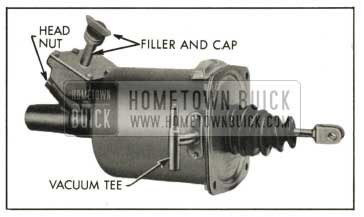
1959 Buick Power Brake Unit
The 1959 Buick power brakes cylinder is connected to the intake manifold through pipes and flexible connections. A large capacity vacuum reserve tank is connected into the vacuum line near the 1959 Buick power brake cylinder to insure quick and smooth response of the brake cylinder on all power brake applications. A check valve installed in the vacuum line closes to maintain existing vacuum at the power cylinder and in the reserve tank whenever manifold vacuum falls below that in the brake system.
When the engine is stopped and the check valve is closed, the tank provides sufficient reserve vacuum for four to seven normal power brake applications. When reserve vacuum does not exist, the brakes can be applied manually in the same manner as the regular brakes, except that somewhat more effort is required.
9-16 REMOVAL, INSTALLATION, ADJUSTING, TESTING OF 1959 BUICK POWER BRAKES UNIT
Removal of 1959 Buick Power Brakes Unit
- Disconnect battery ground strap.
- Disconnect brake pipe from hydraulic cylinder and tape end of pipe to prevent entrance of dirt.
- Remove clevis pin and spring washer from push rod clevis.
- Remove accelerator pedal and roll back floor mat to expose toe plate.
- Remove bolts holding 1959 Buick power brake unit to toe plate.
- Remove toe plate screws and remove toe plate.
- Disconnect vacuum hoses from vacuum tee.
- Remove 1959 Buick power brake unit from car, being careful not to drip brake fluid in car.
- Remove filler cap and turn unit so that any brake fluid will drain out. Pump push rod by hand for full interior drainage. Discard old fluid. Install filler cap and cover hydraulic cylinder outlet with tape to exclude dirt. Clean all loose dirt from outside of unit before disassembling.
Installation of 1959 Buick Power Brakes Unit
- Place 1959 Buick power brake unit in position and connect vacuum hoses to vacuum tee.
- Install toe plate and bolt 1959 Buick power brake unit to plate.
- Install floor mat and accelerator pedal.
- Connect push rod clevis to brake pedal by installing clevis pin and spring washer.
- Connect brake pipe to hydraulic cylinder.
- Connect battery ground strap.
- Bleed hydraulic system according to procedure in paragraph 9-7. Bleed left front wheel cylinder first and check for proper pedal feel. If system still has air in it, bleed other three wheel cylinders.
- After bleeding, bring fluid level to 1/2″-1″ below lip of filler opening and install filler cap.
NOTE: When pressure bleeding equipment is not available, do not use any vacuum assist. The engine should not be running and the vacuum reserve should be used up by repeatedly applying the brake before starting the bleeding procedure.
Testing 1959 Buick Power Brake Unit
- Vacuum Assist. With engine stopped, apply brakes several times until all vacuum reserve in system is used up. Then depress brake pedal and start engine while holding a light pedal pressure. If vacuum system is operating properly, pedal will tend to fall away from under the foot, and less foot pressure will be required to hold pedal in same position. If no action is felt, vacuum system is not functioning.
- Hydraulic Leak. Apply a heavy foot pressure on brake pedal with engine running. Hold this pressure at least 15 seconds and observe brake pedal. If pedal goes down gradually, check first for a leak in system outside of 1959 Buick power brake unit. When possibility of an external leak is eliminated, leak is in hydraulic cylinder of power brake unit.
- Vacuum Leak. Allow engine to idle a minute to build-up vacuum reserve. Shut off engine and wait several minutes at least (system should hold vacuum for 12 hours) before trying brake action. If brake is not vacuum assisted for at least 5 slow ‘ applications there is a leak in the vacuum system. Always check for an external leak before blaming leak on 1959 Buick power brake unit.
- Road Test. Apply brakes several times at about 20 m.p.h. to determine if a light pedal pressure stops the car evenly and quickly. Notice pedal feel as compared to other cars of the same model.
9-17 DESCRIPTION OF 1959 BUICK POWER BRAKE UNIT
Construction of 1959 Buick Power Brake Unit
The 1959 Buick power brake cylinder is the “air suspended” type, meaning that atmospheric pressure is present on both sides of the power piston in the unapplied stage.
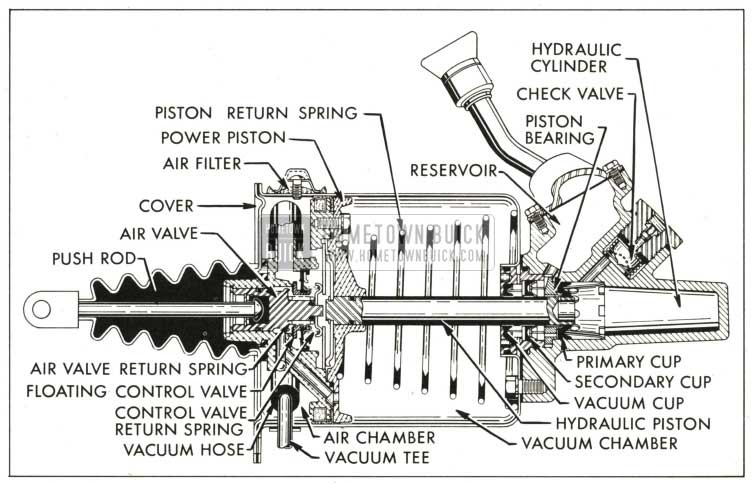
1959 Buick Power Brake Unit-Released Position
As shown in figure 9-13, a cover closes the forward end of the cylinder housing to form a large chamber in which the power piston and related parts operate. The section on the cover side of the piston is called the air chamber since it is open to atmospheric pressure at all times. The section on the opposite side of the piston is called the vacuum chamber since it is subjected to manifold vacuum during power application of brakes. All air entering the cylinder housing passes through an air filter.
The rim of the 1959 Buick power piston carries a spring expanded leather cup and a felt lubricating wick to seal against passage of air. A flexible rubber hose connecting the piston with a vacuum tee on the side of cylinder housing permits the piston to move back and forth while connected to manifold vacuum. Air is exhausted out of the vacuum chamber through passages in the piston and the vacuum hose when the control valve is set for power application.
The related parts which operate in the cylinder housing with the 1959 Buick power piston form an assembly composed of the air valve, floating control valve, hydraulic piston, and the reaction mechanism. Pedal pressure through a push rod starts the power piston assembly moving w4en applying the brakes; a single heavy return spring returns the power piston when releasing the brakes.
The hydraulic piston is a solid steel plunger which extends into the hydraulic cylinder through a vacuum cup, a secondary cup, a piston bearing, and a primary cup. To prevent vacuum from drawing brake fluid out of hydraulic cylinder in case of cup leakage, the space between the vacuum cup and the secondary cup is vented to atmosphere through two openings in the master cylinder to 1959 Buick power cylinder gasket.
Movement of the piston into the fluid filled cylinder displaces a corresponding volume of the fluid, which is forced out into the brake pipes and wheel cylinders. Compensating ports in the counter bored end of the piston permit return of surplus fluid to reservoir when brakes are released. The check valve and spring in the hydraulic cylinder maintains a static residual pressure in brake pipes and wheel cylinders.
Operation of 1959 Buick Power Brake Unit
Description of 1959 Buick power brakes cylinder operation will cover (1) Released Position (2) Applying (3) Reaction Pressure (4) Holding (5) Releasing (6) Manual Applying.
- Released Position. See figure 9-13. The air valve return spring holds the push rod and attached air valve so that the air valve is held clear of the floating control valve. At the same time, the control valve return spring holds the floating control valve against its annular seat on the power piston, thereby closing the passage connected to manifold vacuum.
Atmospheric pressure enters through the air filter into the air chamber, flows through ‘the space between the air valve and the floating control valve, then flows through a passage in the power piston into the vacuum chamber. With the vacuum passage closed and the vacuum chamber open to outside air, the power piston is balanced by atmospheric pressure on both sides and is held against the housing cover by the return spring.
The compensating ports in the counter bored end of the hydraulic piston are open to the area between the primary and secondary cups, permitting flow of brake fluid between the reservoir and hydraulic cylinder as required. The check valve is seated to maintain static pressure in the brake pipes and wheel cylinders.
- See figure 9-14.
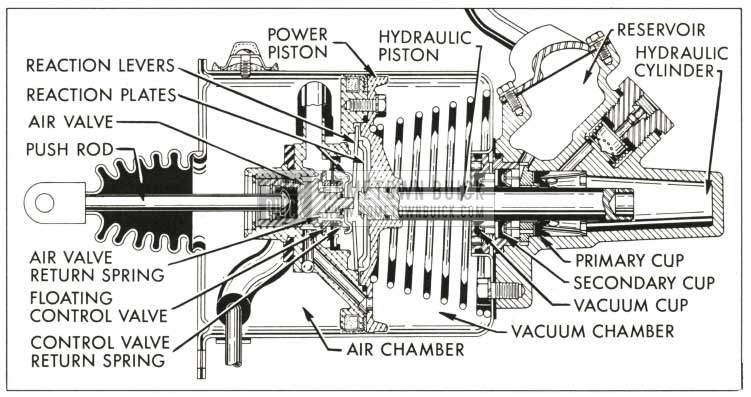
1959 Buick Power Brake Unit-Applying
As the brake pedal is depressed the push rod moves the air valve until its annular seat contacts the floating control valve, at which point atmospheric pressure is sealed off from the vacuum chamber.
Further movement of the air valve pushes the floating control valve away from its annular seat on the power piston, thus connecting the vacuum chamber to manifold vacuum through a passage in power piston and the attached vacuum hose. As air is exhausted out of the vacuum chamber, atmospheric pressure in the air chamber moves the power piston forward toward the hydraulic cylinder. The valve and hydraulic piston move forward as a unit with the 1959 Buick power brakes piston.
As the hydraulic piston is forced into the hydraulic cylinder, escape of fluid into the reservoir is cut off when the piston compensating ports pass through the primary cup, and the fluid displaced by the piston is then forced out into the brake pipes and wheel cylinders to apply the brake shoes. At the same time, a reaction pressure is transmitted back to the brake pedal to give the driver an indication or “feel” of the pressure being applied to the brake shoes.
- Reaction Pressure. As pressure is built up in the brake pipes and wheel cylinders during brake application, the hydraulic piston is subjected to the same pressure. Since the hydraulic piston is free to move rearward in the power piston, the pressure on the piston is transmitted through the attached large reaction plate to the six reaction levers. The outer ends of the levers press against pivot points in the 1959 Buick power brakes piston and the inner ends press against the small reaction plate which now bears against a shoulder of the air valve. See Figure 9-14.
In this manner approximately 40% of the load on the hydraulic piston is transferred through the air valve and push rod to the brake pedal to oppose the foot pressure applied by the driver. This reaction pressure gives the driver a definite indication of “feel” of the pressure being applied to the brake shoes so that he has positive control over the braking operation at all stages.
- When the desired brake apply pressure is reached and brake pedal is held poised, the power piston continues forward momentarily until the annular seat contacts the floating control valve. See figure 9-15.
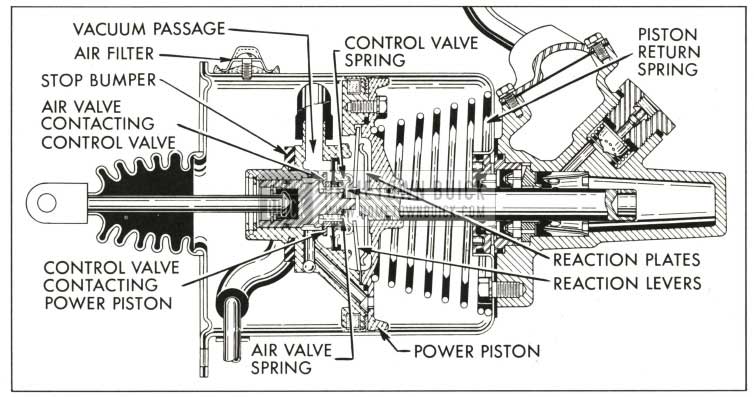
1959 Buick Power Brake Unit-Holding
At this point, the air valve is also in contact with the control valve so that the passages to the vacuum chamber are closed to atmospheric pressure as well as vacuum; therefore, the power piston is held stationary or poised, ready to move in either direction as dictated by brake pedal movement.
As the hydraulic piston moves out of the hydraulic cylinder the fluid from the wheel cylinders flows back into the hydraulic cylinder through the check valve. When the compensating ports in the piston pass through the primary cup, any surplus fluid in the hydraulic system can return to the reservoir. The check valve spring presses the check valve against its seat with sufficient pressure to maintain static pressure in the brake pipes and wheel cylinders.
- Manual Applying. When the engine is not running and all reserve vacuum is exhausted, the brakes are applied entirely by foot pressure on the brake pedal. As the pedal is depressed, the air valve and the floating control valve move first. The end of the air valve then contacts the end of the hydraulic piston. The hydraulic piston moves into the hydraulic cylinder, causing the brakes to be applied in the usual way. However, the pedal pressure for a given brake application is considerably greater. See figure 9-14.
If the engine is started while the brakes are being manually applied, manifold vacuum will exhaust air from the vacuum chamber through the wide open vacuum port at the control valve, and the power piston will move forward. This will make the pedal “fall-away” slightly from under the foot and less foot pressure will be required to hold the pedal in the applied position.
9-18 DISASSEMBLY, INSPECTION, ASSEMBLY OF 1959 BUICK POWER BRAKE UNIT
NOTE: Refer to figures 9-13 thru 9-16 for identification of parts not shown in figures next to overhaul steps.
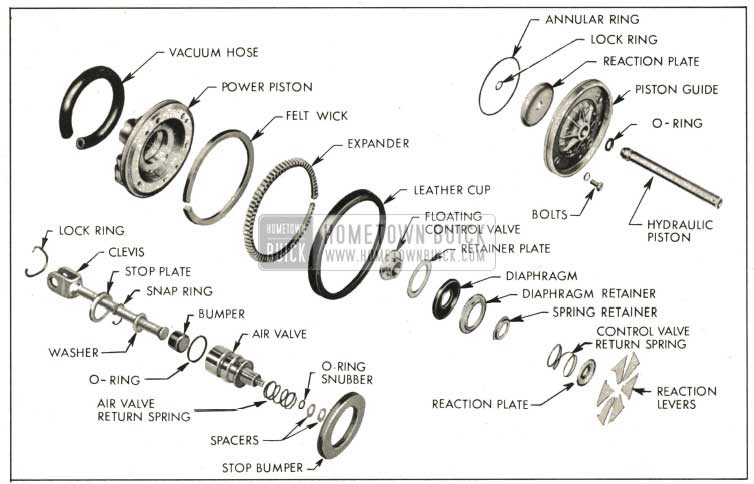
1959 Buick Power Piston Assembly-Exploded View
Disassembly of Power Unit
- Mount 1959 Buick power brake unit in vise with hydraulic cylinder down. Tighten vise only enough to hold cylinder firmly; excessive tightening will distort or crack cylinder.
- Remove push rod boot from housing cover tube and from push rod. Take out air cleaner screw and remove air cleaner cover and filter.
- Take out vacuum tee screws. Remove housing end cover screws, cover and gasket. While holding power piston in, disconnect vacuum hose from vacuum tee and remove tee and gasket from housing. Slowly release power piston to control pressure of piston return spring as piston and attached parts emerge from housing. Make sure that lip of leather piston cup does not catch in holes in housing.
- Pull vacuum hose off power piston only if hose is defective.
- On push rod side of power piston, remove wire lock ring and stop plate from groove and shoulder in power piston.
- Hold power piston assembly with push rod down and pull out push rod and air valve. See figure 9-17. Lift off the spring, spacers (note number of spacers), and O-ring snubber. Remove O-ring from O.D. of air valve.
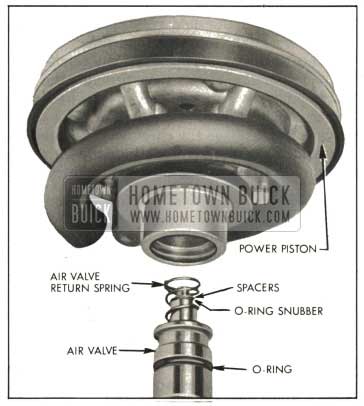
1959 Buick Removing or Installing Air Valve Assembly
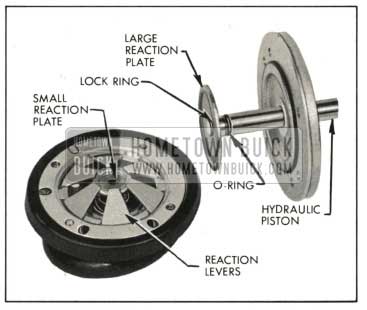
1959 Buick Reaction Mechanism
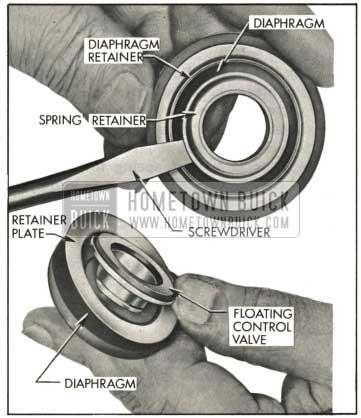
1959 Buick Floating Control Valve and Diaphragm Assembly
This frees retainer plate in the process. Pull diaphragm from diaphragm retainer. This completes disassembly of the power piston assembly.
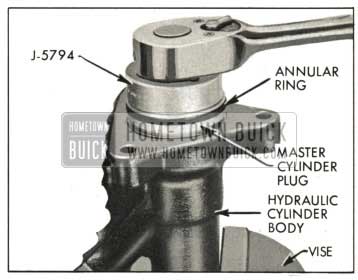
1959 Buick Removing Cylinder Plug
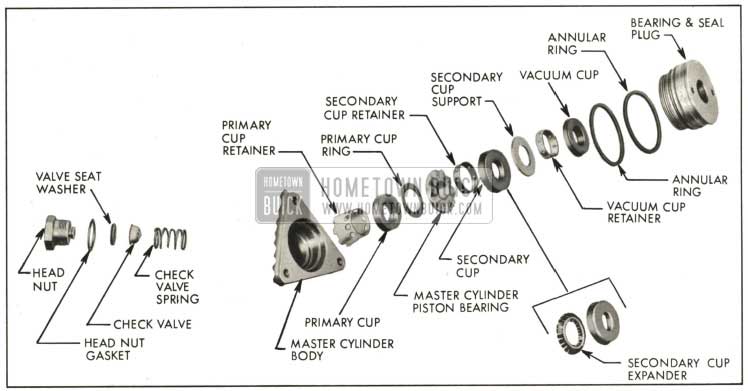
1959 Buick Hydraulic Cylinder Assembly-Exploded
Cleaning, Inspection, Replacement of Parts
As an aid in determining the cause of improper 1959 Buick power brakes operation, wipe fluid from all rubber parts, then carefully examine these parts for nicks, cuts or other damage. After examination discard all these parts.
Thoroughly clean the remaining parts in diacetone alcohol or clean brake fluid.
CAUTION: Do not use anti-freeze alcohol, gasoline, kerosene, or any other cleaning fluid that might contain even a trace of mineral oil, as this could cause serious damage to all rubber parts in the brake system.
Carefully examine the cleaned parts for nicks, burrs, stripped threads, damage or excessive wear. Replace damaged or excessively worn parts or housings. If inside of vacuum power cylinder is rusted or corroded, polish with steel wool or fine emery cloth. Replace if scored.
Make certain that the small compensating ports in end of hydraulic piston are clear. If these ports are plugged, clean them thoroughly and flush the hydraulic system to remove all dirt.
If the outer surface of the air valve or the hydraulic piston show evidence of abrasion, polish out light scores with crocus cloth or very fine polishing paper, then wash and dry thoroughly.
If any parts indicate that heavy abrasive action has resulted from severe contamination of the brake fluid, replace damaged parts and be sure to thoroughly flush the reservoir and wheel cylinder lines.
The 1959 Buick Power Brake Cylinder Overhaul Kit (Group 4.898) contains all necessary replacement parts for the 1959 Buick power brake cylinder. When reassembling the brake cylinder use all the new parts in the kit regardless of whether the old parts appear fit for use. Discard all old rubber parts. In addition, replace any other parts which inspection indicates to be unfit for use.
Lubricate all hydraulic master cylinder parts with clean brake fluid. Lubricate vacuum power piston parts with Dynaflow oil or silicone grease as specified. Silicone grease is supplied in the power brake cylinder overhaul kit. Do not lubricate parts until just before installation.
Assembly of 1959 Buick Power Brakes Unit
- Clamp 1959 Buick hydraulic master cylinder body in vise with threaded outlet hole straight up. Into this hole, place check valve spring. Place new check valve, concave side out, on spring. Place new gasket and stretch new seat washer onto head nut. Set head nut squarely against check valve and press against spring to hold check valve in position while head nut is started in threads. Run down finger tight, back off one or two turns to allow check valve to center, then torque to 90 ft. lbs.
- Reposition hydraulic cylinder body in vise so that reservoir is up. Place gasket and reservoir cover assembly on body and replace six screws. Place gasket on filler cap and tighten in tube.
- Reposition hydraulic cylinder in vise with large bore straight up. Wipe bore and threads with a thin coat of clean brake fluid.
- Into bore, set conical primary cup retainer with notched end in first. Dip primary cup in clean brake fluid and install lip side first over retainer. Center lip of cup must fit into end of retainer. Set primary cup ring of thin blued steel on flat of primary cup. With notched face out, place piston bearing on primary cup ring with hub of bearing fitting into opening in cup, then press home to solid seat. Now set dark secondary cup retainer over center of bearing. Position secondary cup expander on retainer with notched side in.
- On master cylinder plug, install two annular rings on first and third grooves of plug. Do not place an annular ring in center groove which has four small vent holes. Install vacuum cup in bottom of bore flat side down. Position light colored vacuum cup retainer on seal, then install flat secondary cup support on shoulder in bore. Place secondary cup flat side down against support.
- Moisten annular rings on plug with clean brake fluid and screw plug assembly into hydraulic body, checking to see that secondary cup retainer and expander are centered. Use Wrench J-5794 to tighten plug to 30 ft. lbs. Set assembled hydraulic cylinder aside and protect from dirt or damage.
- To assemble floating valve assembly, press flat side of diaphragm retainer (smaller retainer) into diaphragm. See figure 9-19. Hold flat side of retainer plate (larger retainer) against flat side of diaphragm while pressing floating control valve through center hole of diaphragm. Use thumbs to stretch diaphragm over hub of floating control valve, then press spring retainer over valve hub and diaphragm lip. Lubricate O.D. of floating valve with Dynaflow oil and press into place in power piston with rubber face of floating control valve facing in. See figure 9-22.
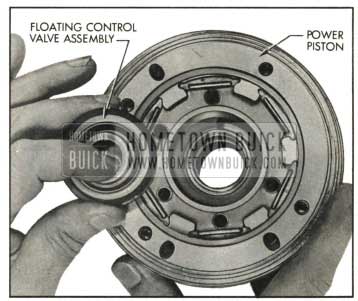
1959 Buick Installing Floating Control Valve and Diaphragm Assembly

1959 Buick Installing Leather Piston Cup
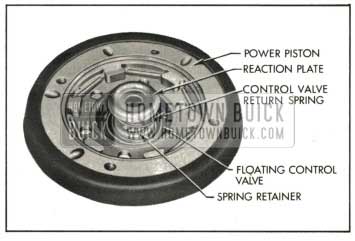
1959 Buick Installing Control Valve Spring and Small Reaction Plate
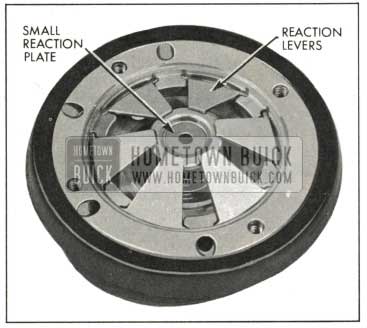
1959 Buick Installing Reaction Levers
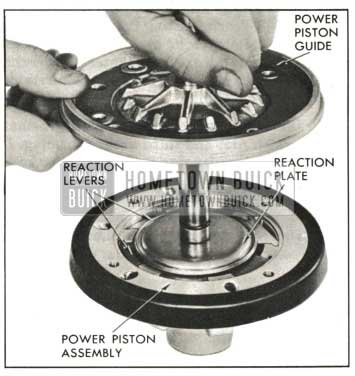
1959 Buick Installing Piston Guide
Hold pressure while sliding piston guide down over hydraulic piston for installation of screws. Note that reaction levers must hold position, piston guide must clamp leather cup while expander and wick hold position under cup, and all holes must align-all at the same time. When correct, install screws. NOTE: To assure that reaction levers are all properly seated, check to see that hydraulic piston has a slight endwise movement in power piston assembly.
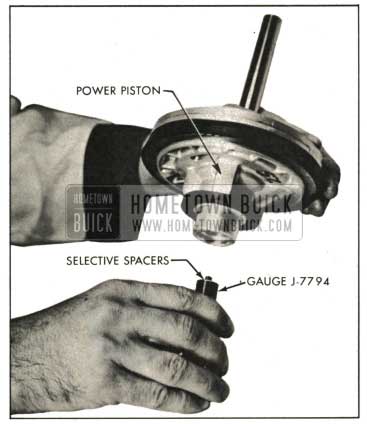
1959 Buick Inserting Gauge and Spacers
(The body of the gauge sets against the smaller reaction plate while the pin of the gauge extends through to contact the hydraulic piston.) Now turn whole assembly over to bring gauge on top and observe gauge pin in gauge body. CAUTION: Hydraulic master cylinder piston must be at lowest limit for correct use of gauge. Do not hold assembly by hydraulic piston or allow hydraulic piston to contact bench.

1959 Buick Air Valve and Related Parts
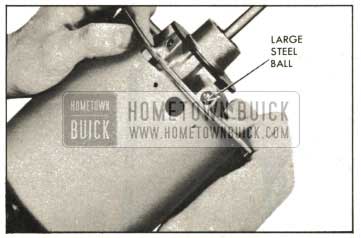
1959 Buick Positioning Piston in Housing
Place gasket against vacuum tube flange. Push piston assembly into housing past vacuum tube hole and insert vacuum tube through hole. Vacuum tube will now hold power piston in place. Slide vacuum hose onto vacuum tube. Hold piston assembly in until vacuum tube attaching screws are tightened, then release piston slowly against tube.
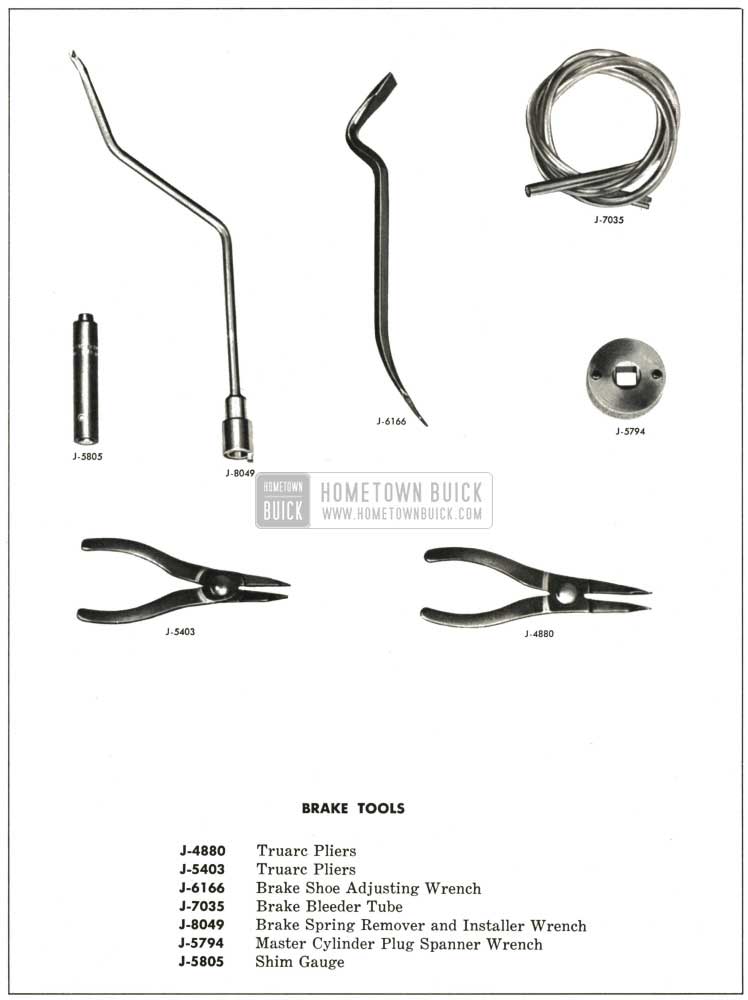
1959 Buick Brake Special Tools

Leave A Comment
You must be logged in to post a comment.